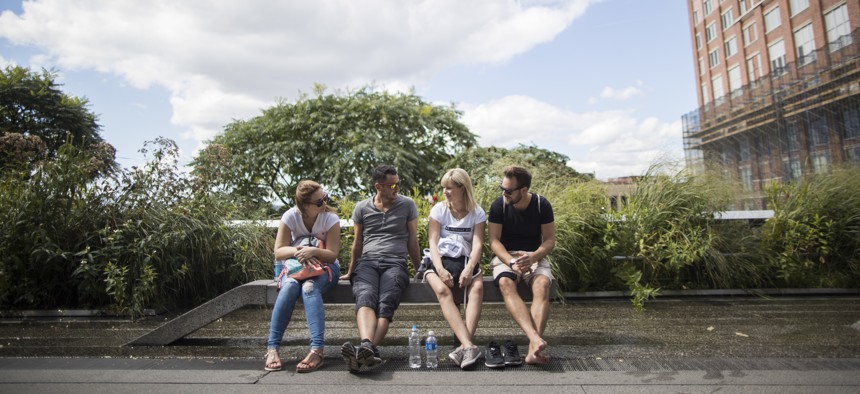Prettier Cities Are Better at Attracting Jobs and New Residents

Visitors take a break on one of the High Line's benches in the Meatpacking District neighborhood of Manhattan. AP Photo
A study finds that the more beautiful a city is, the more successful its economic development prospects, including attracting highly educated and affluent new residents.
In a phenomenon economists call the beauty premium, better-looking people tend to earn more money and are more successful at their careers. But do cities also benefit from a beauty premium? According to a new study by two urban economists, it seems that they do.
The study by Gerald A. Carlino of the Federal Reserve Bank of Philadelphia and Albert Saiz of Massachusetts Institute of Technology, examines the connection between a city’s beauty and key growth indicators. A raft of previous studies have found a connection between economic and population growth and urban amenities (a broad category ranging from parks to restaurants, art galleries, and museums). But this study takes a much closer look at the effects of beauty itself.
To get at this, the researchers measure attractiveness in a unique way: through tourist visits and photos of picturesque locations. The photo data comes from Panoramio, a now-discontinued photo-sharing app embedded in Google Maps that geotagged, aggregated, and curated photos of scenic places around the world. The tourism data comes from the travel consulting firm D.K. Shifflet & Associates.
The study compares its own measure of urban beauty to more established measures of urban amenities such as parks, historic spaces, proximity to coastlines, bodies of waters or mountains, the size of the tourism industry, and more. The researchers look at connections between the features of beautiful places, key indicators of economic growth of cities, and the resurgence and gentrification of neighborhoods in and around the urban center from 1990 to 2010.
The study finds evidence of a significant beauty premium for cities and neighborhoods. A city with twice as many picturesque locations as another city saw 10 percent growth or greater in population and jobs from 1990 to 2010. In fact, urban beauty ties with lower taxes as the most important predictor of overall population growth in cities. Plus, these cities disproportionately attract greater numbers of college graduates. Cities in the top 25 percent of picturesqueness saw nearly 3 percent higher growth in the number of college grads than those in the bottom 25 percent.
Urban beauty also results in higher housing prices and greater housing appreciation. Housing values were 16 percent higher in the top quartile of picturesque cities than the bottom, according to the study. In nearly each and every category, picturesqueness has the biggest effect—more so than tourist visits or other amenities.
City beauty is not an effect of size, the study finds: Smaller and medium-sized places with more parks, historic buildings, proximity to water and mountains, and clearer skies and less rain are perceived as beautiful as well.
It’s not just metros broadly that benefit from an urban beauty premium, it’s specific neighborhoods within them. A large number of studies have documented the back-to-the-city movement of younger, more educated, and more affluent people to the urban center. These studies typically document the urban influx into neighborhoods near the Central Business District (CBD), the downtown commercial core of a city. This gentrification often takes off in the adjacent warehouse, factory, and logistics districts, places like New York’s Soho, Tribeca, or more recently in that city, Chelsea and the Meatpacking District.
The researchers identify a new kind of neighborhood that attracts these newcomers: the Central Recreational District (CRD), defined by the prevalence of parks, historic places, landmarks, tourist destinations—“Instagrammable” locations. For example, think of the tourists swarming along New York City’s High Line, a decade-old park that was created on once unsightly elevated former railroad tracks. The CRD, not the CBD, is the magnet for the back-to-the-city movement, as more affluent and educated people are drawn to the urban center’s abundant amenities and beauty.
“Despite worse initial economic conditions, CRDs managed to grow faster than other comparable neighborhoods,” the researchers write. Rents, incomes, and education increased relatively faster in such beautiful neighborhoods, at the cost of gentrification.” Again, you can see this in the luxury condo towers that have sprung up along the High Line with their high price tags and affluent residents. And they add: “Distance to CBD was mostly irrelevant to the economic and demographic evolution of urban neighborhoods in the U.S., once we control for access to lifestyle amenities. While the American central city generally did not come back in the 1990s, the beautiful city within flourished.”
Beautiful places do not just occur naturally: They are the product of public policy and investment. Of course, some places are endowed with more natural beauty, in the form of stunning coastlines or scenic mountain ranges. But cities can and do make themselves more beautiful—and thus more attractive to educated and affluent people—by investing in parks and protecting landmarks and historic spaces.
Indeed, the study finds that investing 10 percent more in parks and recreation is associated with a 2.3 percent increase in leisure visits and a 1.3 percent increase in employment in the tourism industry. And this is not just a contemporary occurrence. Many of America’s most striking landmarks—its great parks, museums, and architecturally striking public buildings—are products of the City Beautiful movement and New Deal spending.
The upshot: Urban beauty is a powerful tool for economic growth and urban resurgence, but with it comes gentrification and displacement. As the authors of the study put it: “Rents, incomes, and educational attainment increased faster in urban beautiful neighborhoods but at the cost of minority displacement.”
Urban policy makers have to take in the full costs, as well as the benefits, of urban beautification into account. They could mandate that developers who create new condominiums adjacent to publicly created and valued amenities pay more in taxes, provide some affordable housing, or employ local residents in their projects. Cities can devote the increased revenues from beautification projects to affordable housing, workforce development, and the reduction of concentrated poverty.
In fact, the study notes how concentrated poverty is incontrovertibly bad for how tourists perceive a city’s beauty. This, according to the authors, “points to an important motivation for poverty alleviation: By reducing inequality, cities become more attractive for everyone—including the rich.” The more inclusive city is a more beautiful city.
CityLab editorial fellow Claire Tran contributed research and editorial assistance to this article.
Richard Florida is a co-founder and editor at large of CityLab and a senior editor at The Atlantic.
NEXT STORY: One City’s Journey to Filing Complaints About Police Online





